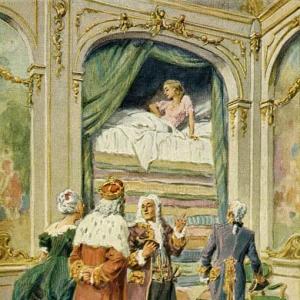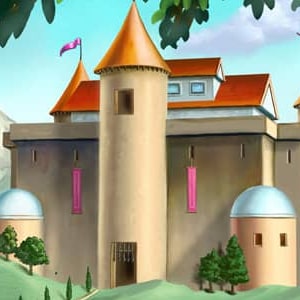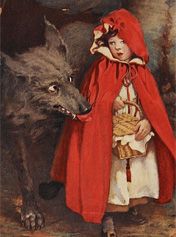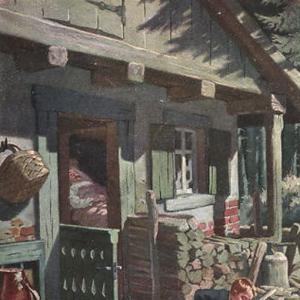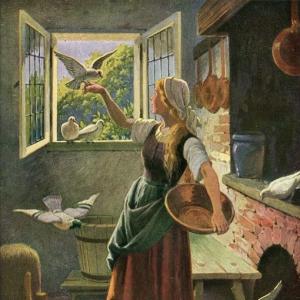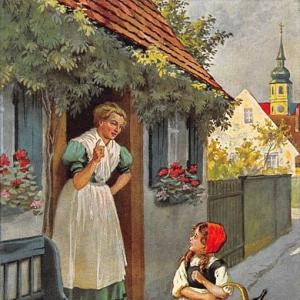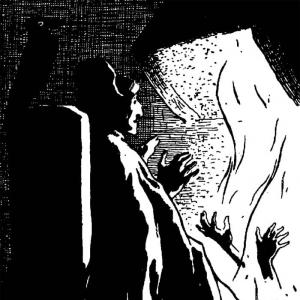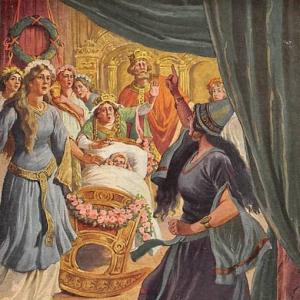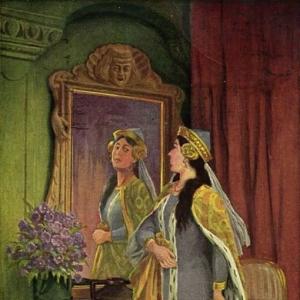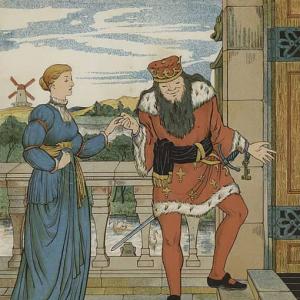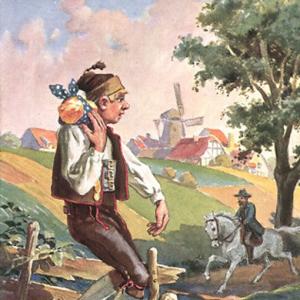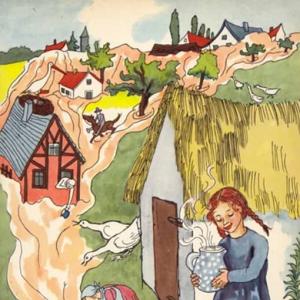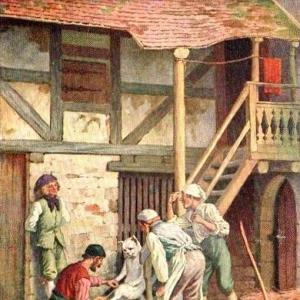Reading time: 6 min
Near the grass-covered rampart which encircles Copenhagen lies a great red house. Balsams and other flowers greet us from the long rows of windows in the house, whose interior is sufficiently poverty-stricken; and poor and old are the people who inhabit it. The building is the Warton Almshouse.
Look! at the window there leans an old maid. She plucks the withered leaf from the balsam, and looks at the grass-covered rampart, on which many children are playing. What is the old maid thinking of? A whole life drama is unfolding itself before her inward gaze.
The poor little children, how happy they are– how merrily they play and romp together! What red cheeks and what angels‘ eyes! but they have no shoes nor stockings. They dance on the green rampart, just on the place where, according to the old story, the ground always sank in, and where a sportive, frolicsome child had been lured by means of flowers, toys and sweetmeats into an open grave ready dug for it, and which was afterwards closed over the child; and from that moment, the old story says, the ground gave way no longer, the mound remained firm and fast, and was quickly covered with the green turf. The little people who now play on that spot know nothing of the old tale, else would they fancy they heard a child crying deep below the earth, and the dewdrops on each blade of grass would be to them tears of woe. Nor do they know anything of the Danish King who here, in the face of the coming foe, took an oath before all his trembling courtiers that he would hold out with the citizens of his capital, and die here in his nest. They know nothing of the men who have fought here, or of the women who from here have drenched with boiling water the enemy, clad in white, and ‚biding in the snow to surprise the city.
No! the poor little ones are playing with light, childish spirits.
Play on, play on, thou little maiden! Soon the years will come– yes, those glorious years. The priestly hands have been laid on the candidates for confirmation; hand in hand they walk on the green rampart. Thou hast a white frock on. It has cost thy mother much labor, and yet it is only cut down for thee out of an old larger dress! You will also wear a red shawl; and what if it hang too far down? People will only see how large, how very large it is. You are thinking of your dress, and of the Giver of all good– so glorious is it to wander on the green rampart! And the years roll by. They have no lack of dark days, but you have your cheerful young spirit, and you have gained a friend– you know not how. You met, oh, how often! You walk together on the rampart in the fresh spring, on the high days and holidays, when all the world come out to walk upon the ramparts, and all the bells of the church steeples seem to be singing a song of praise for the coming spring. Scarcely have the violets come forth, but there on the rampart, just opposite the beautiful Castle of Rosenberg, there is a tree bright with the first green buds. Every year this tree sends forth fresh green shoots. Alas! It is not so with the human heart! Dark mists, more in number than those that cover the northern skies, cloud the human heart. Poor child! thy friend’s bridal chamber is a black coffin, and thou becomest an old maid. From the almshouse window, behind the balsams, thou shalt look on the merry children at play, and shalt see thine own history renewed.
And that is the life drama that passes before the old maid while she looks out upon the rampart, the green, sunny rampart, where the children, with their red cheeks and bare shoeless feet, are rejoicing merrily, like the other free little birds.
 Learn languages. Double-tap on a word.Learn languages in context with Childstories.org and Deepl.com.
Learn languages. Double-tap on a word.Learn languages in context with Childstories.org and Deepl.com.Backgrounds
Adaptions
Summary
Interpretations
Linguistics
„By the almshouse window“ is a lesser-known fairy tale by Hans Christian Andersen, a Danish author who is best known for his collection of fairy tales and children’s stories. Born in 1805 in Odense, Denmark, Andersen gained international fame for his literary works, which include classic tales like „The Little Mermaid,“ „The Ugly Duckling,“ and „The Emperor’s New Clothes.“
Andersen’s fairy tales often incorporate elements of folklore, fantasy, and moral lessons, making them both entertaining and educational for readers of all ages. Many of his stories have been adapted into various forms of media, including films, plays, and ballets, ensuring that they remain popular even today.
„By the almshouse window,“ while not as well-known as some of Andersen’s other works, still embodies his unique storytelling style. The story is set in Copenhagen, the capital city of Denmark, where Andersen spent much of his life. The tale explores themes like the passage of time, the power of memories, human connections, and the cycle of life. These themes are consistent with Andersen’s other works, which often delve into universal human experiences and emotions.
In addition, the story showcases Andersen’s talent for evocative and vivid descriptions of setting and character, as seen through his portrayal of the Warton Almshouse and the old maid. The tale also employs elements of magical realism, intertwining the mundane with the fantastical, which is a hallmark of Andersen’s storytelling.
„By the Almshouse Window“ has been adapted and reimagined in a number of different forms, including:
Film: The fairy tale was adapted into a Danish film in 1942, directed by Johan Jacobsen. The film follows the story of the elderly woman and the young couple, and features beautiful cinematography that captures the rural landscape of Denmark.
Opera: Composer Poul Schierbeck adapted the story into an opera in 1931. The opera was a critical success and is still occasionally performed in Denmark.
Literature: The story has been adapted and retold in various forms of literature, including children’s books and short stories. One notable adaptation is „The Almshouse Lady,“ a short story by Eudora Welty that draws on Andersen’s original tale.
Visual Art: The story has also been the subject of visual art, including paintings and illustrations. In 2013, artist Jesper Christiansen created a series of paintings inspired by the fairy tale, which were exhibited in Denmark.
Theater: The fairy tale has also been adapted for the stage. In 2016, a theater production of „By the Almshouse Window“ was staged in Copenhagen, featuring music and dance to bring the story to life.
Overall, „By the Almshouse Window“ has inspired a range of creative adaptations and reimaginings, highlighting the enduring appeal of Hans Christian Andersen’s timeless fairy tales.
„By the almshouse window“ is a fairy tale by Hans Christian Andersen that revolves around an old maid who lives in the Warton Almshouse, a red house near the grass-covered rampart encircling Copenhagen. As the old maid leans against the window, she watches the poor children playing on the rampart and reminisces about her own past.
The children playing on the rampart are unaware of its history, such as the old story of a child lured into a grave, the Danish King’s oath to protect the city, and the battles fought there. They play with innocent, light hearts, their faces full of joy.
The old maid recalls her younger days, walking on the rampart after her confirmation, wearing a white frock and a red shawl. Time moves forward, and she experiences both joyful and dark moments. She gains a friend with whom she often walks on the rampart, especially during spring when the beautiful Castle of Rosenberg comes to life with green buds.
However, life does not always bring happiness. Her friend’s life is cut short, and the old maid is left to grow old alone. She now watches the merry children from behind her window, seeing her own history reflected in their play.
The fairy tale ultimately portrays the passage of time and the cycle of life, as the old maid reminisces about her past while observing the children, who represent her own history, innocence, and the promise of the future.
„By the almshouse window“ by Hans Christian Andersen offers several interpretations and themes that can be analyzed:
The passage of time and life’s transience: The story reflects on the fleeting nature of life, as the old maid looks back on her own history and sees it mirrored in the children’s play. It is a reminder that time passes quickly, and that youth and innocence give way to age and experience.
The power of memories: The old maid’s reminiscing demonstrates the power of memories in shaping our lives and emotions. As she recalls her past, she experiences a range of emotions, from joy to sorrow, emphasizing the impact memories can have on an individual’s well-being.
The cycle of life: The tale highlights the cyclical nature of life, with the old maid observing the children who represent her past and the potential of the future. It showcases how life moves in cycles, with one generation giving way to the next.
The importance of human connection: The story emphasizes the value of friendship and companionship, as seen through the relationship between the old maid and her friend. Their bond brings happiness and solace in difficult times, illustrating the significance of human connections in shaping our lives.
Resilience in the face of adversity: The old maid’s journey through life is not without hardships and loss. Yet, she remains resilient and continues to find moments of happiness despite her circumstances. This theme showcases the human capacity for resilience and the ability to find beauty and joy even in difficult situations.
Overall, „By the almshouse window“ offers a poignant exploration of the passage of time, the power of memories, the cycle of life, the importance of human connections, and the resilience of the human spirit.
The fairy tale „By the Almshouse Window“ by Hans Christian Andersen can be analyzed linguistically to uncover various stylistic and thematic elements that contribute to its emotional depth and narrative style.
Narrative Style and Tone
The narrative employs a melancholic and reflective tone, characteristic of Andersen’s storytelling. Through the eyes of an old maid, the passage examines themes of innocence, nostalgia, and the passing of time. This reflective tone is achieved through a contemplative narrative voice that seamlessly blends observation with introspection.
Lexical Choices
Diction of Poverty and Age: Words like „poverty-stricken,“ „poor,“ and „old“ establish a sense of decay and nostalgia, contrasting the innocence and vitality of the children outside.
Imagery of Youth and Innocence: Descriptions such as „red cheeks,“ „angels‘ eyes,“ and „light, childish spirits“ highlight a stark contrast between the playful children and the reflective, solitary life of the old maid.
Symbolism
The Rampart: Serves as a symbolic boundary between past and present, youth and age, innocence and experience. It is both a physical location and a metaphorical threshold where different stages of life and history converge.
Children Playing: Represent innocence and the pure, untainted joys of life. Their ignorance of the historical significance of the rampart adds to this symbolism.
Balsam and Flowers: The flowers in the window symbolize both beauty and transience, echoing the maid’s youthful past and her current state.
Historical References
The text weaves in elements of Danish history and folklore. The tale of a child lured into an open grave and the story of a Danish king swearing to protect his city contribute to a rich tapestry of cultural memory.
Themes
Innocence vs. Experience: The juxtaposition of children playing and the old maid reflecting on life highlights the fleeting nature of youth and the inevitability of aging.
Nostalgia and Longing: The maid’s memories of her own past joy and subsequent sorrow reflect a universal longing for the simplicity and freedom of youth.
Life’s Transience: Andersen employs the cycle of seasons and the metaphor of the rampart to emphasize life’s inevitable progression from birth to death.
Personification: Elements like „bells of the church steeples seem to be singing“ imbue the setting with a sense of life and continuity.
Metaphors and Similes: Comparisons, such as likening dewdrops to „tears of woe,“ convey deeper emotional resonance and thematic depth.
Conclusion
Andersen’s „By the Almshouse Window“ utilizes rich linguistic and symbolic elements to engage the reader in a contemplative exploration of time, memory, and the contrasts between youthful innocence and aged reflection. Through poignant imagery and layered narrative, the story transcends its historical and cultural specificity to offer universal insights into the human condition.
Information for scientific analysis
Fairy tale statistics | Value |
|---|---|
| Translations | DE, EN, DA, ES |
| Readability Index by Björnsson | 30.4 |
| Flesch-Reading-Ease Index | 79.8 |
| Flesch–Kincaid Grade-Level | 6.6 |
| Gunning Fog Index | 9.1 |
| Coleman–Liau Index | 9.1 |
| SMOG Index | 8.7 |
| Automated Readability Index | 7.4 |
| Character Count | 3.666 |
| Letter Count | 2.868 |
| Sentence Count | 38 |
| Word Count | 679 |
| Average Words per Sentence | 17,87 |
| Words with more than 6 letters | 85 |
| Percentage of long words | 12.5% |
| Number of Syllables | 874 |
| Average Syllables per Word | 1,29 |
| Words with three Syllables | 35 |
| Percentage Words with three Syllables | 5.2% |

 Facebook
Facebook  Whatsapp
Whatsapp  Messenger
Messenger  Telegram
Telegram Reddit
Reddit
